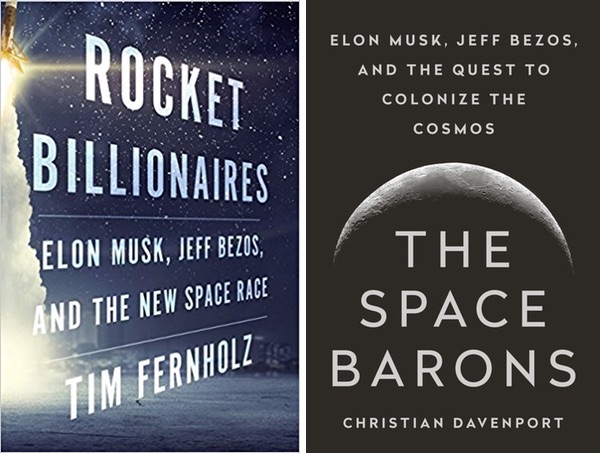Reviews: Rocket Billionaires and The Space Baronsby Jeff Foust
|
| Bezos said in 1999 he always wanted to start a space company, Stephenson recalled. “Well, why don’t you start it today?” he told Bezos. |
I made those recommendations not having read the books themselves, since they were still weeks away from being published (both were officially released last Tuesday.) Now, having read both, I can feel more confident—and maybe relieved—in recommending them. Individually and together, they provide a detailed overview of the rise of a new space industry and the personalities powering it. Both are general enough to provide an introduction to newcomers, but with enough details to enlighten even those who have closely followed the industry.
As the subtitles of both books suggest, the central figures in both books are Bezos and Musk, who have used wealth generated in other businesses to pursue their passions in space. The similarities between the two largely end there, though: Musk has been the hare, moving quickly, and publicly, to develop launch vehicles and spacecraft, while Bezos has been the tortoise, spending years in R&D and only now edging closer to suborbital operations with an orbital vehicle in development. (Blue Origin’s coat of arms, after all, features two tortoises and a Latin motto that roughly translates as “step-by-step, ferociously.”)
We see those differences play out, and the rivalry between the two companies grow, over the course of both books. The arc of both companies, including both their achievements and their setbacks in both technology and business and policy, are well known to readers of this publication. Both books not only recount them but also fill in some lesser-known details. For example, in The Space Barons, we learn that Blue Origin had its roots in a conversation Bezos had with a friend, science fiction author Neal Stephenson, after seeing a screening of the film October Sky in 1999. Bezos said he always wanted to start a space company, Stephenson recalled. “Well, why don’t you start it today?” he told Bezos. Stephenson would become an early employee of Blue Origin.
Rocket Billionaires recounts some of the early meetings Musk had that led to the formation of SpaceX, including witnessing engine firings at a Rocket Research Society test site in the Mojave Desert. When one test exploded, taking out a test stand, Musk turned to Tom Mueller, who would be one of the first employees of SpaceX, and said, “Tom, make sure we build two test stands.”
The books are not exclusively about Bezos and Musk. Richard Branson and Virgin Galactic have a supporting role in both books, discussing how SpaceShipOne won the Ansari X PRIZE and the ongoing, extended development of SpaceShipTwo. However, the perception in both books that Virgin Galactic and suborbital space tourism, once at the frontier of the new commercial space era when SpaceX had yet to launch its first rocket and Blue Origin was still largely in stealth, had been passed by companies leveraging personal wealth and NASA contracts. (The Space Barons also includes a little bit about Paul Allen’s renewed interest in space with Stratolaunch, and a cameo by Andy Beal, the billionaire who in the late 1990s plowed a couple hundred million dollars into Beal Aerospace, whose Texas test site would later be taken over by SpaceX.)
| Because of those complementary aspects, one book isn’t clearly better than the other, but combined offer a bigger picture of the development of Blue Origin and SpaceX, and to a lesser extent Virgin Galactic. |
While the two books cover similar topics, they complement each other in some respects, as each book brings up or emphasizes different aspects of the companies’ development. Rocket Billionaires, for example, discusses how SpaceX did troubleshooting for the arrival and berthing of the first Dragon mission to the International Space Station in 2012; The Space Barons goes behind the scenes regarding the thruster problem that jeopardized a Dragon mission to the station in 2013.
Because of those complementary aspects, one book isn’t clearly better than the other, but combined offer a bigger picture of the development of Blue Origin and SpaceX, and to a lesser extent Virgin Galactic. If you had to choose, The Space Barons is perhaps slightly better. Davenport had somewhat better access, including interviewing Bezos and Musk (the Bezos interview, he recounts, took significant effort to secure even those he works for the Bezos-owned Washington Post); Fernholz was able to interview Musk, but appears to rely more heavily on unnamed government and industry sources mentioned throughout the book.
Rocket Billionaires also had, at least in the review copy, a number of primarily chronological errors. An example is the passage that, after the Challenger accident in 1986, “Lockheed Martin put together the Titan IV”: not only did Lockheed Martin not exist until the mid-1990s merger of Lockheed and Martin Marietta, planning for what would become the Titan IV was already underway prior to the accident because of an Air Force desire not to rely exclusively on the shuttle. Another passage refers to the “success of Scaled Composites’ SpaceShipOne a week before [Mike] Griffin’s confirmation hearing”: Griffin’s confirmation hearing to be NASA administrator came in April 2005, six months after SpaceShipOne’s final, prize-winning flight.
Both, however, are good books, and worth reading for insights into the Blue Origin and SpaceX, their founders, and their interactions with other companies and with government. Those interactions will only increase as SpaceX prepares to begin launching NASA astronauts and military satellites, while Blue Origin shows an interest in also getting into the market for government launches with its New Glenn orbital vehicle. Perhaps the books will also be worthwhile reading for a Cabinet official taking a bigger role in oversight and promotion of commercial space.
